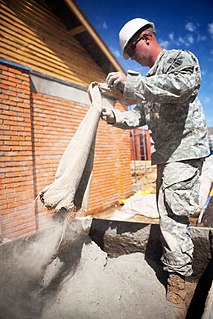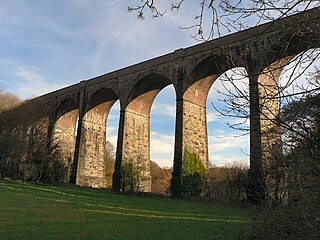
Aberthaw Cement Works are cement works in the Vale of Glamorgan near the village of East Aberthaw in Wales.

Aberthaw Cement Works are cement works in the Vale of Glamorgan near the village of East Aberthaw in Wales.
The Blue Lias limestone of Aberthaw was a source of hydraulic lime from early times, and it was made famous when it was selected by John Smeaton for the construction of the Eddystone Lighthouse but various records of Aberthaw Blue Lias limestone's processing are not consistent. Evidently, limestone pebbles from Aberthaw's coastline were transported inland for burning at other limekilns but much was shipped across the Bristol Channel from the Port of Aberthaw, for burning at Three Kilns, Cleeve Hill, near Watchet, Somerset. One historical account states that John Smeaton used Watchet's burned lime which was shipped to Millbay, Plymouth for his Eddystone lighthouse construction in 1756. It was not until 1888 that a (pebble) limeworks and kilns, were constructed alongside Pleasant Harbour, East Aberthaw but that works, which had become rail-served by 1892, closed in 1926. It is on record that geologically, the limestone seam at Aberthaw runs under the Bristol Channel and is also present at Watchet.
The Aberthaw and Bristol Channel Portland Cement Company was established in 1912 by the Beynon family. The site at Aberthaw was chosen as it was near the necessary raw material, limestone and coal from the South Wales coalfield which was needed to heat the kilns. The works started in 1914 with two small wet process kilns with a production capacity of 120 tonnes per day each. The first consignment of cement left Aberthaw works by rail in 1914. A third wet kiln was ordered in 1913 and erected in 1916 during the first World War, and a fourth kiln was added and running by June 1958. This brought clinker capacity to 1200 tonnes per day.
In 1967, Kiln 5 ( 51°23′51″N3°23′38″W / 51.39743°N 3.393965°W ) was installed. This was a much more efficient dry process kiln. The wet process kilns were decommissioned in 1974, and Kiln 6 - also a dry kiln - ( 51°23′51″N3°23′40″W / 51.397507°N 3.394326°W ) was started in 1975. Kiln 6 remains in operation today.
In 1919 the company took over the nearby Aberthaw and Rhoose Point Portland and Lime Company. Blue Circle bought the two sites at Aberthaw and Rhoose in 1983. In 1987, Rhoose Works closed and was later completely demolished. The former Rhoose works kiln firing fuel had gone from coal to oil, then gas. The same applied to Aberthaw but reversion to coal came in 1979 but Aberthaw plant was authorised to burn whole tyres as fuel from 2013, with no impact on the environment.
Lafarge Cement UK bought Blue Circle industries PLC in 2001, creating the largest cement maker in the world. Cement from the site is carried to destinations by Road and Rail (rail services being provided by Freightliner heavy haul and Colas Rail over the Vale of Glamorgan Line). In July 2020, it was observed that Aberthaw cement in bulk was being shipped in large consignments by PCA rail tank wagons equipped for pressure unloading at destination, thus considerably reducing the number of bulk cement road tankers on the highways.
Watercolour artist Thomas Frederick Worrall worked for a few years at the cement works from when it was first opened. [1]

A cement is a binder, a substance used for construction that sets, hardens, and adheres to other materials to bind them together. Cement is seldom used on its own, but rather to bind sand and gravel (aggregate) together. Cement mixed with fine aggregate produces mortar for masonry, or with sand and gravel, produces concrete. Concrete is the most widely used material in existence and is behind only water as the planet's most-consumed resource.

The Vale of Glamorgan, often referred to as The Vale, is a county borough in Wales, bordering Bridgend, Cardiff, and Rhondda Cynon Taf. With an economy based largely on agriculture and chemicals, it is the southernmost unitary authority in Wales. Attractions include Barry Island Pleasure Park, the Barry Tourist Railway, Medieval wall paintings in St Cadoc's Church, Llancarfan, Porthkerry Park, St Donat's Castle, Cosmeston Lakes Country Park and Cosmeston Medieval Village.

A lime kiln is a kiln used for the calcination of limestone (calcium carbonate) to produce the form of lime called quicklime (calcium oxide). The chemical equation for this reaction is

Lime is a calcium-containing inorganic mineral composed primarily of oxides, and hydroxide, usually calcium oxide and/ or calcium hydroxide. It is also the name for calcium oxide which occurs as a product of coal-seam fires and in altered limestone xenoliths in volcanic ejecta. The word lime originates with its earliest use as building mortar and has the sense of sticking or adhering.

The Vale of Glamorgan Line is a commuter railway line in Wales, running through the Vale of Glamorgan from Barry to Bridgend, via Rhoose and Llantwit Major.

Rhoose Point is a headland and a settlement near the village of Rhoose in the Vale of Glamorgan, Wales. Rhoose Point is the most southerly settlement of Wales. It may also be the southernmost point of mainland Wales, although this has also been claimed for nearby Breaksea Point. The Vale of Glamorgan Council had installed a permanent notice verifying Rhoose Point as the most southerly part of Wales's mainland and there is a small stone circle marking the point.

Cadoxton railway station is a railway station serving Cadoxton and Palmerstown near Barry, Vale of Glamorgan, South Wales. It is located on the Barry Branch 6½ miles (10 km) south of Cardiff Central. The line continues to the terminus of the Barry Branch at Barry Island but from Barry Junction the line also continues as the Vale of Glamorgan branch to Bridgend via Rhoose for Cardiff International Airport bus link and then Llantwit Major.

Aberthaw is an area containing the villages of East Aberthaw and West Aberthaw, on the coast of South Wales about 5 miles (8 km) west of Barry. It is home to Aberthaw Cement Works, Aberthaw Lime Works, and Aberthaw Power Station, a coal power station that is linked to the South Wales Valleys via the Vale of Glamorgan Railway. The area is historically within the parish of Penmark in the Vale of Glamorgan. The two villages of West and East Aberthaw are separated by the River Thaw. The village of East Aberthaw, near Rhoose, has a 13th century pub. The village Baptist Chapel and Mission Room, no longer exist as such and have been converted for other uses.

Aberthaw Power Station refers to two decommissioned coal-fired and co-fired biomass power stations on the coast of South Wales, near Barry in the Vale of Glamorgan. They were located at Limpert Bay, near the villages of Gileston and West Aberthaw. The most recent power station on the site, Aberthaw B Power Station, co-fired biomass and as of 2008 had a generating capacity of 1,560 megawatts (MW). The power station closed on 31 March 2020.

Blue Circle Industries was a British public company manufacturing cement. It was founded in 1900 as the Associated Portland Cement Manufacturers Ltd through the fusion of 24 cement works, mostly around on the Thames and Medway estuaries, together having around a 70% market share of the British cement market. In 1911, the British Portland Cement Manufacturers Ltd was formed by the addition of a further 35 companies, creating a company with an initial 80% of the British cement market.
The Vale of Glamorgan Railway Company was built to provide access to Barry Docks from collieries in the Llynvi, Garw and Ogmore areas. Proposed by the coalowners but underwritten by the wealthy Barry Railway Company, it opened in 1897 from near Bridgend to Barry, in Wales.

Penwyllt is a hamlet located in the upper Swansea Valley in Powys, Wales.
Adelaide Brighton Cement (ABC) is an Australian manufacturer of cement, lime and dry blended products.

Blue Anchor is a seaside village, in the parish of Old Cleeve, close to Carhampton in the Somerset West and Taunton district of Somerset, England. The village takes its name from a 17th-century inn; the bay, Blue Anchor Bay, was previously known as Cleeve Bay. The bay and inn were the subjects of a watercolour by JMW Turner in 1818, now in the Lady Lever Gallery, Port Sunlight.

Aberthaw Lime Works is a derelict structure, located on the South Wales coast, between Fontygary Bay and Aberthaw Power Station. The structure is a Grade II Listed Building. The structure is considered a listed building because it is a well preserved structure from an important regional industry.
Aberthaw High Level railway station was a Vale of Glamorgan Railway station operated by the Barry Railway which served Aberthaw, located near the north shore of the Bristol Channel in the former Welsh county of South Glamorgan, and in the current county of Vale of Glamorgan.
Aberthaw Low Level railway station was the Taff Vale Railway station which served East Aberthaw, located near the north shore of the Bristol Channel in the Welsh county of Glamorgan.

The West Somerset Coast Path is a long-distance footpath that links the northern end of the South West Coast Path to the River Parrett Trail in Somerset, England, UK.

Porthkerry Viaduct is a railway viaduct near Barry in the Vale of Glamorgan, Wales.

Hope Cement Works, is a cement plant located near to the village of Hope in Derbyshire, England. The plant is mostly self-contained with its own shale and limestone quarries adjacent, with only fuel and small amounts of additives needing to be brought in. The site is located inside the Peak District National Park, and so is subject to tighter planning restrictions than other cement plants in the United Kingdom. It is now the largest cement plant in the United Kingdom, and is also one of the largest emitters of CO2 within the national park.